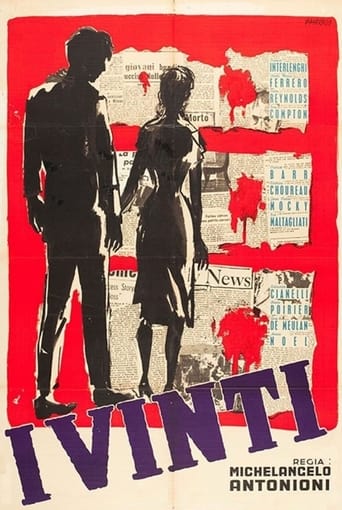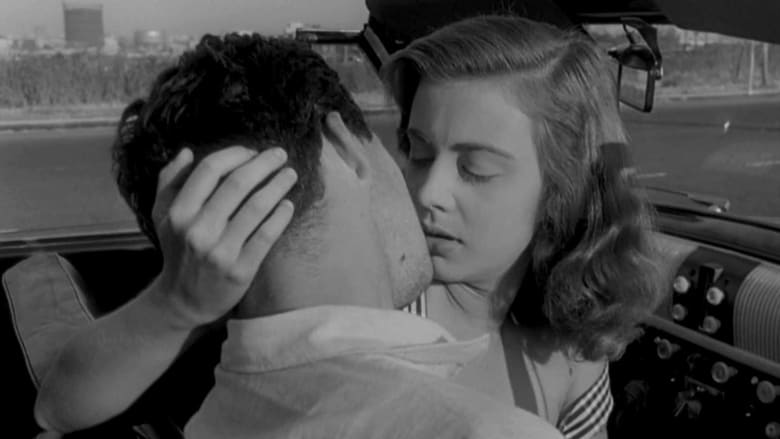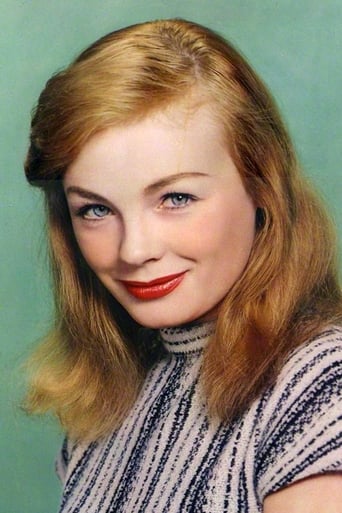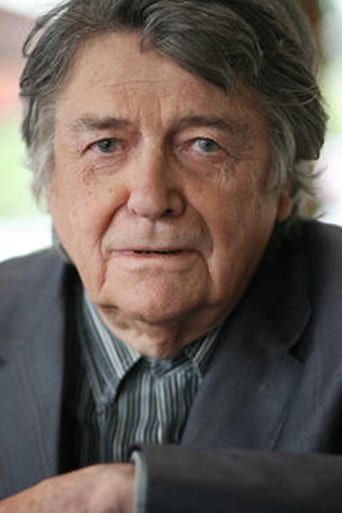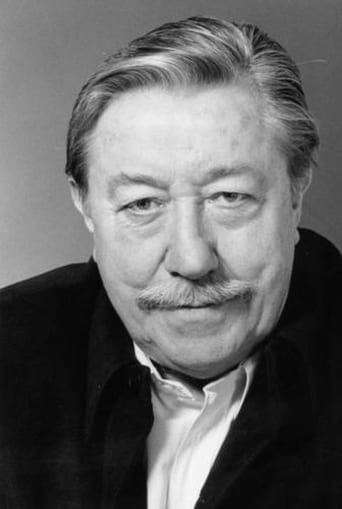The Vanquished (1953)
A trilogy of stories of well-off youths who commit murders. In the French episode, a group of high school students kill one of their colleagues for his money. In the Italian episode, a university student's involved in smuggling cigarettes. In the English episode, a lazy poet finds the body of a woman on the downs, and tries to sell his story to the press.
Watch Trailer
Cast


Reviews
In truth, there is barely enough story here to make a film.
Wow! What a bizarre film! Unfortunately the few funny moments there were were quite overshadowed by it's completely weird and random vibe throughout.
It was OK. I don't see why everyone loves it so much. It wasn't very smart or deep or well-directed.
Blistering performances.
This is the only one of Antonioni's films that was clearly reshaped, to some degree, by the censors. It begins and ends with moralistic announcements about how the youth of the film's post-war today treat murder and brutality as a path towards notoriety in the press, implying that the political upheaval of the era had made the kids bloodthirsty. This "public service announcement" then demonizes both the characters of the film, many of whom will commit or take credit for a murder, and the insurrectionary movements that were gripping Italy at the time, with the voice of a prosaic humanism that was wholly alien to Antonioni, and the true spirit of this work.The triptych of stories of youth in major European cities getting violent is, as is typical of the auteur, extremely detached and non-judgmental. The first, about a bunch of Parisian kids killing their rich friend, is pretty prosaic both narratively and visually. The one exception to the latter is a great shot when a huge, remote control plane comes diving down on a field from nowhere, technology once again making the natural world seem alien and unnatural as it so often does for this director.Perhaps the strongest, if not the most intriguing, segment is the middle one in the filmmaker's native language. The student son of a boughie Rome family gets involved with smuggling for kicks, and ends up very much living the consequences of his criminal path. This is the closest Antonioni ever came to making pure noir, with a brilliant chase scene on and through a bridge, with magnificent chiaroscuro compositions. This segment, with its privileged rebel earning the consequences of a violent path, seems to me to be a pre-cursor of Antonioni's magnum opus, The Passenger.The final, English segment has many, widely reported, elements that will be more fully developed in Blow-Up. In both, an off-putting British youth finds a murder victim in a park and attempts to exploit it for media/art's sake. There are a few fine examples of "Antonioni streets" and character blocking, but mostly this segment is notable for how authentically British it feels, much more so than Blow-Up.The afore mentioned book-ending add ons by the authorities try to shift the audience's perspective to that of the jury that confronts the main subject of one of the segments. But they're not fooling anyone. As he revealed in his "English language trilogy" Antonioni clearly identifies with the random violence of the "youth of today" and perhaps sees it as necessary for liberation. When the lead character of one segment announces that, "the end of a human life is of no significance" we are meant to identify with the speaker, not shudder at his words
I recently saw this film for the first time, directed by Italian director Michelanegelo Antonioni in 1953, and have a number of questions that I hope forum members may be able to answer. The film has three stories of murder committed by juvenile delinquents, and includes one shot in England with English actors and locations. The main actors featured are Peter Reynolds, Patrick Barr, Fay Compton, Eileen Moore & Raymond Lovell and most of the half-hour of screenplay is shot on location in London.My first question concerns the sound track. The DVD copy I saw claims to have the original soundtrack, but it seems that the actor's words have been dubbed in after shooting - possibly a necessity in view of the large amount of exterior location footage. Raymond Lovell's "voice" is clearly not his - no hint of his easily recognizable lisp or slight accent. The other actor's would appear to be correct - as this was Lovell's last film role, perhaps he was deceased before the voice - overs had been completed? Also, does anybody know where the interior shots were filmed? There are a few, inside a newspaper office, in a court room and a house - were these filmed at a studio in the UK, and if so, which? I couldn't find any info about this at IMDb.For those who like location footage of London this is a must see. As well as shots at Piccadilly Circus and other central London locations, there is also an excellent shot taken at the junction of Carshalton Road with Sutton High Street - identifiable because the names of both roads can be easily read. Lots of buses, cars and motor vehicles can be seen in clear detail, as well as shots at (presumably) Piccadilly Circus underground station.Hopefully someone here will have some more information about the filming of the English segment of this film,
As introduced by Lorenzo Codelli, The Vanquished consists of 3 short stories taking place one each in Italy, France and England, which while not a successful commercial film of the time, it garnered strong reviews, cementing Michelangelo Antonioni as a director with a critical audience and not considered a commercial director. And I agreed that all the characters here have rather interesting backgrounds and stories, and the England segment has Blowup written all over it, serving as a precursor to one of Antonioni's more famous works.The movie begins quite documentary like, with a prologue touching on violence and the wayward youths of the post-WWII generation. Like outcasts who challenge conventional societal norms, the 3 stories with youth characters in pro/antagonist roles puts a fictional spin to the numerous articles and newsreels that set the tone of the movie.The first segment is set in France, and I felt was the strongest of the lot. With a myriad of characters, it tells of six friends embarking on a trip sans their parents' concerns, but as they set up their excursion, you can't help but feel that something's amiss, and character motivations are not quite what they seem. For example, why are two boys packing a pistol to bring along? And what's with the manipulative Simone (Etchika Choureau) up to, dangling a carrot in front of different boys, being probably one of the masterminds, and chief executioner of some hideous plan? How about the braggart Pierre, who flaunts his wealth around by lighting cigarettes with money bills, and boasting of a model girlfriend, but in fact has to borrow 100 francs? It's classic bluff against bluff with plenty of jealous and envious emotions thrown in for a good mix, together with survivor styled alliances being formed, that you just aren't too sure who's in cahoots with whom. It's a perfect short which builds on your anticipation, with a tinge of mystery and foretelling of a gruesome, inevitable crime to be committed, and the ending being the cherry on top.The Italian segment was unfortunately the blandest of the lot. It highlights how most families and parents especially being clueless to their offspring's disillusionment and life of demeanours. Here, the parents of Claudio (Franco Interlenghi) have absolutely no idea that their son is running a smuggling racket, and knows neither his friends, or his girlfriend, except for a photograph in his room. We then follow Claudio throughout the short, watching him seek out his girl Marina (Anna-Maria Ferrero), who's obviously from a well to do family, and uses the excuse of living the life of crime to build up capital so that he can elope with her to a place they can call their own. Not too interesting, though it did make me dig deep and wonder about the many crimes committed out of passion or using love as a crutch.I'm not sure but I felt the England segment had a wry humour filled thread with a faceless receptionist at The Daily Witness. Just when I thought I had heard the last from this person, it gets popped up again and I can't help but to chuckle. So far the movies in the retrospective have been rather grim and serious, but here's a sliver of wit that I didn't see coming, if expected at all, and so however short it was, I thought it opened one big refreshing window.I can't make out much of the tennis game here which lasted no longer than a few seconds, but the England segment draped itself with, as mentioned earlier, plenty of elements which would later be referenced, used and explored further in Blowup. While Blowup didn't feature the crime in progress, this short however provided some probable clues, and did the conventional through an enactment, a luxury which audiences in Blowup, or even Story of a Love Affair, never got to see, and can only imagine if and how it happened. Ken Whatton (Patrick Barr), a journalist of The Daily Witness doesn't provide any interesting insights in the movie but serves his function as a proxy for the more interesting Aubrey Hallan (Peter Reynolds) from Saffron who discovers a dead body, and calls him up to provide him the front page scoop material. The Aubrey character runs along the theme on exploring delusional youths, as he's a fame seeker who doesn't think twice in cutting corners to the path of glory and money, putting a lot of pride in himself in being able to analyze and make money from dog races.However, he's quite a tragic character in living his dream and not giving a hoot about being pragmatic, and holds onto his poetry to overcome his unrequited love for Sally. And in fact, most of the characters in all the shorts have dreams, and it is their inability to fulfill their dreams with concrete workable plans in a down to earth, hard/smart working manner, and in their wanting to make a name for themselves overnight, that they resort to unorthodox, risky behaviour with little responsibility or perhaps even the awareness of consequences in their actions.
This was Antonioni’s third film and arguably his rarest from the pre-AVVENTURA period. Taking an episodic structure, it is a sober treatment of juvenile delinquency – showing a widespread alienation affecting the youth of the post-war years in various European cities. The film has a rough, torn-from-the-headlines feel to it – even if the director’s perspective isn’t nearly as acute as in his later, more polished work (tending also towards preachiness, beginning from the opening montage).The French episode shows a gang of aimless youth from working-class families cold-bloodedly planning and carrying out the murder of a boastful bourgeois companion of theirs out of envy. The Italian part is more conventional, though featuring some nice noir-ish atmosphere in its tale of a petty smuggler who commits murder in panic, is hurt trying to escape from the police and dies on reaching his home (having in the meantime confessed to his girl). It stars Franco Interlenghi (who appeared in similar ‘denunciations’ by other Italian master film-makers, namely Vittorio De Sica’s SHOESHINE [1946] and Federico Fellini’s I VITELLONI [1953]) and Eduardo Ciannelli, back home after a distinguished Hollywood career as a character actor.The English segment – involving the discovery of a body in the park – rather serves as an interesting precursor to the much more celebrated (and abstract) BLOW-UP (1966), It emerges as the best episode, again revolving around a conceited character – only this time it’s he who turns to crime just for kicks (he relishes, even invites all the ensuing publicity). The victim is played by Fay Compton (from Orson Welles’ OTHELLO [1952]), while Patrick Barr (perhaps best-known as the retired blind judge in Pete Walker’s infamous HOUSE OF WHIPCORD [1974]) is the reporter hero.For the record, Antonioni was involved with four other feature-film compendiums throughout his career – LOVE IN THE CITY (1953), the little-seen I TRE VOLTI (1965), BEYOND THE CLOUDS (1995) and his swan-song EROS (2004; which I had the privilege of watching during the Venice Film Festival, with the director sitting just a few paces away from me!).

